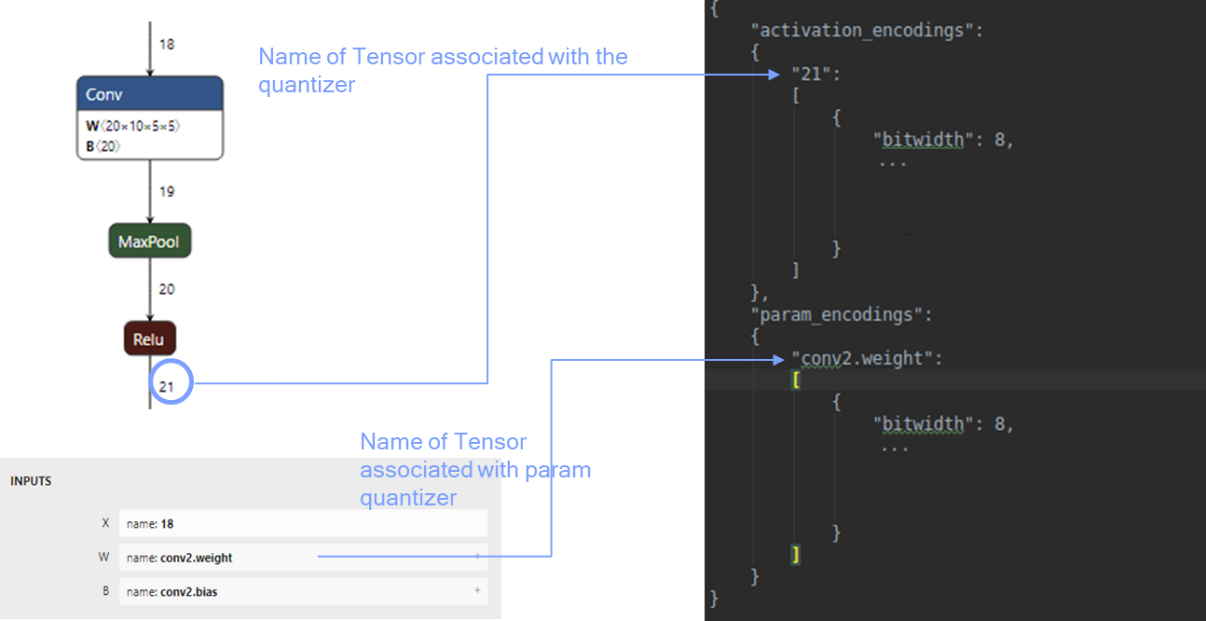AIMET Quantization Simulation determines scale/offset values for activation and parameter tensors in the model. This scale/offset information is also referred to as ‘quantization encoding’. When a model is exported from the AIMET Quantization Simulation feature, an encoding file is also exported that contains quantization encodings for the model. This encoding file can then be used by an inference runtime when running the model on-target.
The following specification describes the format of this encoding file produced by AIMET.
Encoding Format Specification¶
The encodings from Quantization simulation can be exported for usage on run-time. The encoding file uses a JSON syntax. The file format is usable with both PyTorch and TensorFlow models, that maps tensor names with the encodings.
1. Versioning¶
Encoding format will follow XX.YY.ZZ versioning format as describe below,
XX= Major RevisionYY= Minor RevisionZZ= Patching version
Change in major revision should indicate substantial change to the format, updates to minor version indicates additional information element being added to encoding format and might require update to fully consume the encodings. The patching version shall be updated to indicate minor updates to quantization simulation e.g. bug fix etc.
2. Version 0.4.0 (up to)¶
The encoding format as defined below is backward compatible and shall applicable to all exported encoding up to version 0.4. In case, where versioning information is missing the encoding is assumed to follow version 0.4 format.
2.1. Encoding Specification¶
“version”: “string”
“activation_encodings”:
{
<tensor_name>: [Encoding, …]
}
“param_encodings”
{
<tensor_name>: [Encoding, …]
}
Where,
"version”is set to “0.4.0”<tensor_name>is a string representing the tensor in onnx or tensorflow graph.
Encoding is as defined below,
Encoding:{
bitwidth: integer
is_symmetric: string
max: float
min: float
offset: integer
scale: float
}
Where,
bitwidth: constraints >=4 and <=32is_symmetric: allowed choices “True”, “False”
if a tensor is assigned more than one Encoding then the encoding is at per channel basis.
2.2. Encoding File Example for PyTorch¶
On PyTorch, the tensor names shall be derived from the ONNX named model representation as depicted below on a sample model.

Given below is the sample format with keys and values for encodings JSON output file on PyTorch.
{
“version”: “0.4.0”
"activation_encodings": {
"20":
[
{
"bitwidth": 8,
"is_symmetric": “False”,
"max": 2.6086959838867188,
"min": -2.109158515930176,
"offset": -114.0,
"scale": 0.018501389771699905
}
],
"21":
[
{
"bitwidth": 8,
"is_symmetric": “False”,
"max": 2.558866932988167,
"min": -0.12636379897594452,
"offset": -12.0,
"scale": 0.010530316270887852
}
],
},
"param_encodings": {
"conv2.weight":
[
{
"bitwidth": 8,
"is_symmetric": “False”,
"max": 0.06318144500255585,
"min": -0.06268782913684845,
"offset": -127.0,
"scale": 0.0004936049808748066
}
],
"fc1.weight":
[
{
"bitwidth": 8,
"is_symmetric": “False”,
"max": 0.05589814856648445,
"min": -0.05546144023537636,
"offset": -127.0,
"scale": 0.0004367042565718293
}
],
}
}
2.3. Encoding File Example for TensorFlow¶
Given below is a sample format with the keys and values for encodings on TensorFlow graph (in JSON format).
{
“version”: “0.4.0”
"activation_encodings": {
"conv2d/Relu:0":
[
{
"bitwidth": 8,
"is_symmetric": “False”,
"max": 2.184721499681473,
"min": -0.10788747668266296,
"offset": 11,
"scale": 0.0089906234367221
}
],
"conv2d_1/Relu:0":
[
{
"bitwidth": 8,
"is_symmetric": “False”,
"max": 2.1020304188132286,
"min": -0.10380396991968155,
"offset": 11,
"scale": 0.008650330936207491
}
],
},
"param_encodings": {
"conv2d/Conv2D/ReadVariableOp:0":
[
{
"bitwidth": 8,
"is_symmetric": “False”,
"max": 0.1462666392326355,
"min": -0.1451239287853241,
"offset": 126,
"scale": 0.0011427081098743512
}
],
"conv2d_1/Conv2D/ReadVariableOp:0":
[
{
"bitwidth": 8,
"is_symmetric": “False”,
"max": 0.08333279937505722,
"min": -0.08268175274133682,
"offset": 126,
"scale": 0.0006510374592799766
}
]
}
}
3. Version 0.5.0¶
3.1. Encoding Specification¶
“version”: “string”
“activation_encodings”:
{
<tensor_name>: [Encoding, …]
}
“param_encodings”
{
<tensor_name>: [Encoding, …]
}
Where,
"version”is set to “0.5.0”<tensor_name>is a string representing the tensor in onnx or tensorflow graph.
‘Encoding’ structure shall include an encoding field “dtype” to specify the datatype used for simulating the tensor.
Encoding:{
dtype: string
bitwidth: integer
is_symmetric: string
max: float
min: float
offset: integer
scale: float
}
Where,
dtype: allowed choices “int”, “float”bitwidth: constraints >=4 and <=32is_symmetric: allowed choices “True”, “False”
when dtype is set to ‘float’, Encoding shall have the following fields
Encoding:{
dtype: string
bitwidth: integer
}
bitwidth defines the precision of the tensor being generated by the producer and consumed by the
downstream consumer(s).
3.2. Encoding File Example for PyTorch¶
Given below is a snippet of the sample format with change highlighted.
{
“version”: “0.5.0”
"activation_encodings": {
"20":
[
{
“dtype”: “int”
"bitwidth": 8,
...
}
],
...
},
"param_encodings": {
"conv2.weight":
[
{
“dtype”: “int”
"bitwidth": 8,
...
}
],
...
}
}
3.3. Encoding File Example for TensorFlow¶
Given below is a snippet of the sample format with change highlighted.
{
“version”: “0.5.0”
"activation_encodings": {
"conv2d/Relu:0":
[
{
“dtype”: “float”
"bitwidth": 16,
],
...
},
"param_encodings": {
"conv2d/Conv2D/ReadVariableOp:0":
[
{
“dtype”: “float”
"bitwidth": 16,
}
],
...
}
